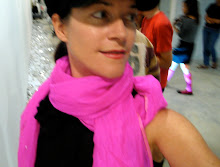Not only did live art by artists represent the very spirit of its own times and reveal the ways in which artists from different disciplines interconnected, it also showed me how certain ideas in a painting or a sculpture, which as a traditional art historian I might have looked for in other paintings or sculptures, often originated in some sort of performed action. Indeed, the history of performance throughout the twentieth century showed performance to be an experimental laboratory for some of the most original and radical art forms; it was a freewheeling, permissive activity for intellectual and formalist excursions of all kinds that could, if studied carefully, reveal layers of meaning about art and artmaking that simply were not clear before.As designers we often create works that live through print or on screen. Part of the need to mass produce spurs this on, to communicate to large audiences. It is often part of our task. But living behind a screen can be isolating — and as communication people, a hunger grows to get out and meet the audience. It's often not possible with huge campaigns. It's often part of the PR and marketing team to handle those aspects. But creating a one way flow of information is almost like talking to yourself. Sometimes being in the moment with your audience, making your audience take part in the actual process of the design (or art) can lead to incredible insights while also allowing for a freedom of experimentation not allowed in a final polished thing.—Roselee Goldberg, introduction
Performance, Live Art Since 1960
Many creatives have recognized the potential of experimenting in real time. There is the cost and the immediacy as lures, there is also a sense of play and inclusiveness. Our audience is with us, our critics are our players. it can be immensely satisfying to have closure in a sense. of course these moments are experiments or sketches that do get translated. and the translations do go further to reach larger less local or immediate audiences. but during the actual creation and 'painting', we are engaged with others and communicating in real time, in the same space. it's almost rebellious, in the sense that so little is made this way today.
When i worked as a more traditional designer, I met with others within my office to discuss strategy, to report progress, to delegate duties and to present pitches. rarely did i include others in my making process, rather i showed and moved on to the next stage of implementation. I was lucky in that i did see my audience at times, and could get a sense of the reception of my work. Also working within events, i went and saw the events and documented them. But in those days, other than the costume parties I threw, making things for the audience to create wasn't really something possible. We made things for the audience to observe.
Part of my fascination with experiences, is that of the immersive possibilities. There is something about creating a communication piece that must be engaged in and made manifest through that engagement that is so full of potential. Say I want to communicate 'collaboration' — what better way than to get my audience to collaborate— to understand not only conceptually, but also physically. this is compelling.
I've looked deeply into the Futurists and Dadaists, into performances from the Surrealists and Constructivists to Black Mountain College and the Fluxus period, and they tap into this thing I'm drawn to, but I've found that i need to look further afield. And so Masturis and rituals, ceremonies and pilgrimages have been pulling my attention and absorbing my research time.
The concept of pulling a person totally into an experience to communicate to them is ancient. It's part of the core of Borobudur, of Angkor Wat and of mountains like Taishan. We must engage in the space to read and glean the meaning. the meaning is there, but not accessible from a distance. it requires pedestrian focus, you must walk to know. I love that concept.


No comments:
Post a Comment